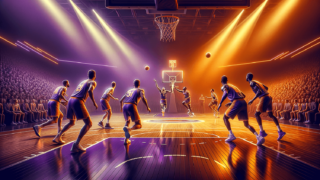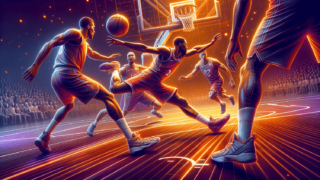
Ten-Second Line Violation Rule in Basketball
Written by: Basketball Universe
Last updated:

Picture this – the game is at a crucial moment, the stakes are high, and the tension is palpable in the stadium. That’s when the ten-second violation rule in basketball comes into play, a seemingly minor yet momentous rule that can shift the dynamics of an entire match. This captivating basketball regulation may often fly under the radar, but for true hoops aficionados, understanding every intricate detail is imperative. So, put on your virtual sneakers and get ready to sprint through the fundamental aspects of this elusive game-changer, from its history and purpose to its implications on offensive strategies. It’s time to master the seemingly innocuous but incredibly pivotal ten-second line violation rule!
Ten-Second Line Violation Rule in Basketball
The Ten-Second Line Violation Rule in basketball refers to the rule where the offensive team has ten seconds to advance the ball across the midcourt line. Failure to do so by the offensive team results in a turnover, and the defensive team gains possession of the ball. This rule is implemented to prevent stalling and promote faster gameplay, pushing teams to strategize and execute more efficient offensive plays.
A Brief History of the Ten-Second Rule
Before diving into the intricacies of the Ten-Second Line Violation Rule, it’s essential to understand its history. The rule has been an integral part of basketball since the early 1930s when the game transitioned from a slow-paced, methodical sport to a more dynamic and high-scoring spectacle. During that time, the stalling and deliberate attempts of teams to maintain possession prompted the establishment of this rule. Now that you have a grasp of the rule’s origins let’s delve into its various aspects, which break down into several fascinating subtopics.
The Purpose of the Ten-Second Rule
The primary purpose of the Ten-Second Line Violation Rule is to encourage a faster, more offensive style of play that rewards quick decision-making, teamwork, and athleticism. By instilling a sense of urgency into a team’s offensive approach, the rule prompts players to think on their feet and engage in more strategic and versatile plays. Consequently, the rule transforms the game into a more exciting, electrifying, and captivating event for both players and fans alike.
Preventing Stalling
One of the most critical aspects of the rule is its focus on preventing stalling – a tactic in which a team deliberately slows down play to maintain possession, control the clock, and manipulate the outcome of a game. Before the Ten-Second Rule was established, stalling was rampant, allowing teams to exploit this loophole and win games by merely keeping the ball out of their opponents’ hands. By imposing a time constraint, the rule effectively counters the stalling strategy and heightens the action.
Maintaining Competitive Balance
In addition to preventing stalling, the Ten-Second Rule also ensures a competitive balance between basketball teams. By limiting the time they have to cross the midcourt line, the game becomes more challenging for the offense and strategically engaging for the defense. In turn, this engenders a well-rounded, competitive game with fewer opportunities for any one team to dominate the court for extended periods.
Anatomy of a Ten-Second Violation
Now that we know what the Ten-Second Rule is and its importance in the game, let’s delve into the details of how a violation occurs, what factors can lead to a violation, and the methods officials use to enforce the rule for optimum gameplay.
When the Clock Starts
The ten-second count starts the moment an offensive player gains possession of the ball, either through rebounds, steals, or inbound passes. Once the count begins, players must act swiftly to pass or dribble the ball safely across the midcourt line within the allotted timeframe.
What Constitutes Crossing the Line
Crossing the midcourt line is not as simple as merely dribbling or passing the ball past it. To successfully advance beyond the ten-second count, both the player and the ball must cross the line. In other words, the player cannot merely pass the ball to a teammate who is already past the midcourt line. Furthermore, any part of the player’s body or the ball touching the line is still considered to be in the backcourt, and a violation will not be avoided until they fully cross the line.
Enforcement by Referees
Basketball officials play a crucial role in enforcing the Ten-Second Rule, as they are responsible for initiating and monitoring the count. The officials use both visual and mental counting methods to ensure that the offensive team is held accountable for meeting the time constraint. In NBA games, there are dedicated shot clocks near half-court to provide more accurate timing, making it easier for the officials to enforce the rule.
Strategies and Plays to Avoid Ten-Second Violations
Expert coaching, teamwork, and smart offensive plays are all essential factors in avoiding the Ten-Second Line Violation Rule. In this section, we’ll delve into various strategies and plays that can help a team navigate around this critical constraint.
Effective Rebounding and Outlet Passing
One of the most potent deterrents to ten-second violations is speedy rebounding and efficient outlet passing. Teams must practice securing defensive rebounds and immediately channeling the ball to a guard or fast-breaking teammate. This rapid transition from defense to offense will reduce the likelihood of a violation and put the opposing team on their heels.
Ball Movement and Quick Decision-Making
Teams that move the ball swiftly and decisively are less likely to experience ten-second violations. Quick passes, timely dribbles, and assertive decision-making play a vital role in creating space, disrupting defensive schemes, and advancing the ball up the court before the dreaded ten-second clock expires.
Knowledge of Opposing Team’s Defensive Strategies
Heightened awareness and knowledge of the opposing team’s defensive strategies can also be invaluable in alleviating the threat of a ten-second violation. By anticipating and adapting to various defensive tactics, teams can exploit weaknesses in their opponents’ strategies, ensuring fluid ball movement and safe passage into the frontcourt.
Practice Drills and Muscle Memory
Frequent practice under the pressure of the ten-second constraint will pay dividends during high-stress game situations. By incorporating drills that simulate this pressure in practice, players can form muscle memory and situational awareness that enable them to remain calm and precise when met with this challenge during gameplay.
High-Profile Examples of Ten-Second Violations
To further emphasize the rule’s significance, let’s take a look at some prominent examples of ten-second violations that have occurred throughout basketball history. These attention-grabbing moments help demonstrate how the Ten-Second Rule can directly impact the outcome of a game.
Michigan Wolverines vs. Northwestern Wildcats – 2013
Michigan faced a full-court press from Northwestern during an intense 2013 game. With 2.9 seconds remaining, Michigan held onto a two-point lead, but a crucial ten-second violation led to an unfortunate turnover. Northwestern gained possession of the ball and capitalized on this opportunity, tying the game and sending it into overtime. This memorable moment exemplifies the dramatic impact the Ten-Second Rule can have on the game’s outcome.
San Antonio Spurs vs. Miami Heat – 2019
Derrick White of the San Antonio Spurs struggled against the Miami Heat’s lockdown defense during this 2019 NBA game. The Heat’s aggressive pressure resulted in a pivotal ten-second violation against the Spurs, leading to a late-game momentum shift. The Miami Heat used this crucial play to push on to victory, showcasing the power of the Ten-Second Rule in altering a game’s course.
The Ten-Second Rule in Different Basketball Leagues
The Ten-Second Line Violation Rule is a cornerstone of many basketball leagues worldwide, but the specifics may differ slightly across various organizations. Here, we break down the similarities and differences of the rule as applied in the NBA, NCAA, FIBA, and WNBA.
NBA and WNBA
Both the NBA and WNBA adhere to the ten-second backcourt violation as described previously. Officials initiate a count as soon as an offensive player gains possession of the ball, and the offense must clear the midcourt line within ten seconds. Failure to do so results in a turnover, and the defensive team takes possession.
NCAA
In NCAA (college) basketball, the ten-second violation is also implemented. However, the NCAA altered its rules in 2013 to include a slight modification – if the offensive team calls a timeout, the ten-second count does not reset. Once play resumes, the count continues from where it left off at the timeout.
FIBA – International Basketball
FIBA, the international governing body of basketball, also enforces the ten-second backcourt violation. However, in FIBA rules, the count resets if a defensive player deflects the ball out of bounds. This subtle exception differs from the NBA, WNBA, and NCAA, marking a unique aspect of FIBA-regulated games.
Expanding Your Basketball Rules Knowledge
Acquiring a comprehensive understanding of basketball rules such as the Ten-Second Line Violation Rule can drastically enhance your appreciation and enjoyment of the game. More importantly, a firm grasp of the rule and its nuances allows players to excel and put their skills to the test, outwitting opponents and composing masterful plays in the face of intense pressure. The world of basketball is deep and complex, and every new bit of knowledge brings you closer to the game you love.
Impact of Ten-Second Violations on Game Tempo
The Ten-Second Line Violation Rule plays a significant role in dictating a basketball game’s tempo. By imposing this constraint on the offense, teams are compelled to execute rapid plays and push the pace on the court. As a result, the game becomes a fast-paced, high-energy affair with frequent transitions from one end of the floor to the other. Although the rule’s primary goal is to deter stalling, its impact on game tempo offers fans an exhilarating experience and promotes an energetic environment for the players.
The Role of Press Defense in Causing Ten-Second Violations
Defensive strategies are often designed to exploit the Ten-Second Line Violation Rule for generating turnovers and disrupting the offense. One such strategy is the press defense, in which opposing players apply relentless pressure on the ball handler, attempting to force a ten-second violation or create chaos that leads to a steal. By doing so, defensive teams can heighten their chances of regaining possession or, at the very least, slow down their opponents’ offensive rhythm.
Full-Court Press
One of the most common forms of press defense is the full-court press, which aims to apply pressure on the ball handler in the backcourt immediately after an inbound pass. By forcing the dribbler to navigate through a gauntlet of defenders with the ten-second clock ticking away, the defense can create ample opportunities for turnovers or provoke rushed decisions from their opponents.
Half-Court Press
A less aggressive alternative to the full-court press is the half-court press, in which defensive players apply pressure once the offense has crossed the midcourt line. Although the ten-second violation isn’t the primary focus in this approach, its principle of forcing the offense to make rapid decisions remains relevant. By employing a half-court press, defenses aim to generate turnovers by overwhelming the offense, trapping them in tight spots, or coercing them into contested shots or risky passes.
Inbound Strategies to Counter Ten-Second Violations
While press defenses can exploit the Ten-Second Line Violation Rule, offenses can develop special plays and strategies to counteract the pressure. Here, we’ll explore several inbound strategies that can help dodge potential ten-second violations, enabling a smooth transition into the frontcourt.
Triangle Formation
A classic inbound play to counter press defenses is the triangle formation. In this strategy, the inbound passer is supported by two teammates situated close to the baseline and another positioned closer to the midcourt line, forming a triangular shape. The passer can choose to engage the closer teammates, who can quickly pass the ball to the distant teammate or rely on tactical off-the-ball movement to advance the ball up the floor.
Screen the Screener
Another effective play to beat the press and avoid a ten-second violation is the “screen the screener” technique. In this approach, an offensive player sets a screen for a teammate to receive the inbound pass, then immediately receives a screen from a third player. This rapid sequence of screening actions can create enough confusion and open lanes for the ball handler to navigate the press defense and advance the ball up the court.
Utilizing the Big Man as a Pressure Release
In situations where the press defense proves too overwhelming for the guards, offenses can involve their big men as pressure release options. The big man takes up a position close to the baseline after the inbound pass, acting as an outlet for the ball handler. By staying close to the baseline and using their size and strength to secure the ball, they can initiate a swift passing sequence with team members further up the court without risking a ten-second violation.
Understanding the Rules for Enhanced Gameplay
Comprehending and embracing the Ten-Second Line Violation Rule and other basketball rules is pivotal for players, coaches, and fans alike. Effectively maneuvering through these constraints helps develop smarter, more strategic gameplay and enhance the overall enjoyment of this enthralling sport. So, go ahead, share your newfound knowledge with fellow enthusiasts and marvel at the on-court brilliance unfolding before your eyes!
FAQ Section: Ten-Second Line Violation Rule in Basketball
While we have discussed the Ten-Second Line Violation Rule in depth, you may still have some burning questions about this fascinating basketball regulation. To help you become a true basketball aficionado, we have compiled a list of 10 frequently asked questions, complete with concise answers that provide the necessary information to satisfy your curiosity.
1. What are the penalties for a Ten-Second Violation?
A team that commits a Ten-Second Violation faces a turnover, which means they lose possession of the ball to the opposing team. This has significant potential consequences, as it can lead to opportunities for the other team to score points or gain the upper hand in the game.
2. How is a Ten-Second Violation signaled by the officials?
When a referee observes a Ten-Second Violation, they signal it by raising one arm with an open hand and blowing their whistle. The other referees will also blow their whistle while mirroring the signal, ensuring that all players on the court are aware of the violation taking place.
3. Does the clock stop after a Ten-Second Violation?
Yes, the game clock is stopped when officials signal a Ten-Second Violation. Once possession has been awarded to the opposing team, the clock resumes once the ball is inbounded and touched by a player on the court.
4. Can the Ten-Second Rule be reset by calling a timeout?
In the NBA and WNBA, the ten-second count does not reset after a timeout. However, in NCAA basketball, a 2013 rule change states that the ten-second count does not reset after a timeout, and the count continues from where it left off when play resumes.
5. How do different leagues handle violations on the shot clock?
Most basketball leagues, including the NBA, WNBA, NCAA, and FIBA, follow the same guideline – a team must clear the midcourt line within ten seconds. However, slight variations exist when it comes to resetting the count after timeouts (NCAA) or defensive deflections out of bounds (FIBA).
6. How do press defenses exploit the Ten-Second Rule?
Press defenses use aggressive tactics, such as tight man-to-man coverage and full-court pressure, to force offensive players to make quick decisions, heightening the chances of turnovers or ten-second violations. The intense defensive pressure seeks to disrupt the flow of the offense and control the game’s tempo.
7. Is there an eight-second rule in basketball?
There is no eight-second rule in basketball. The rule you may be referring to is the Ten-Second Line Violation Rule, which is a regulation that mandates teams to advance the ball beyond the midcourt line within ten seconds of gaining possession.
8. Are there situations that reset the Ten-Second Violation count?
Yes, certain situations reset the count, such as a kicked ball violation or an offensive foul called in the backcourt. In FIBA-regulated games, a defensive player deflecting the ball out of bounds also resets the count. However, timeouts do not reset the count in NCAA games.
9. Can a player call a timeout to avoid a Ten-Second Violation?
A player can call a timeout to avoid a Ten-Second Violation, but depending on the league, the ten-second count may not reset. In the NBA and WNBA, the count resets after a timeout, but in NCAA games, the count resumes from where it left off after the timeout ends.
10. What are some key strategies for avoiding Ten-Second Violations?
Key strategies to avoid ten-second violations include effective rebounding and outlet passing, quick decision-making, strong ball movement, opponent defensive analytics, and incorporating pressure-tested practice drills. These tactics enable teams to develop their skills, stay composed, and navigate the challenges posed by the Ten-Second Rule.
Featured Posts
- No pillar pages found.





